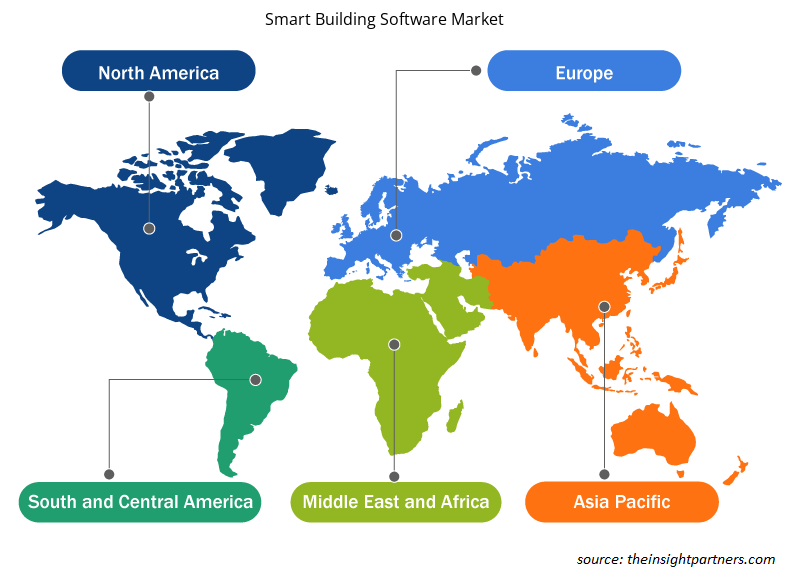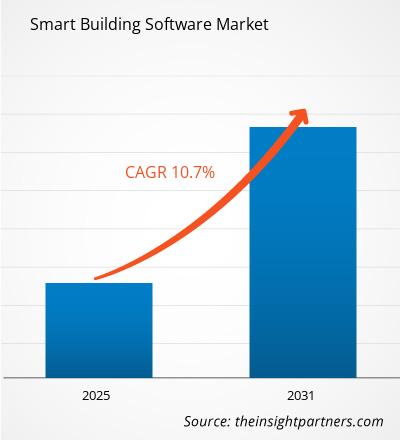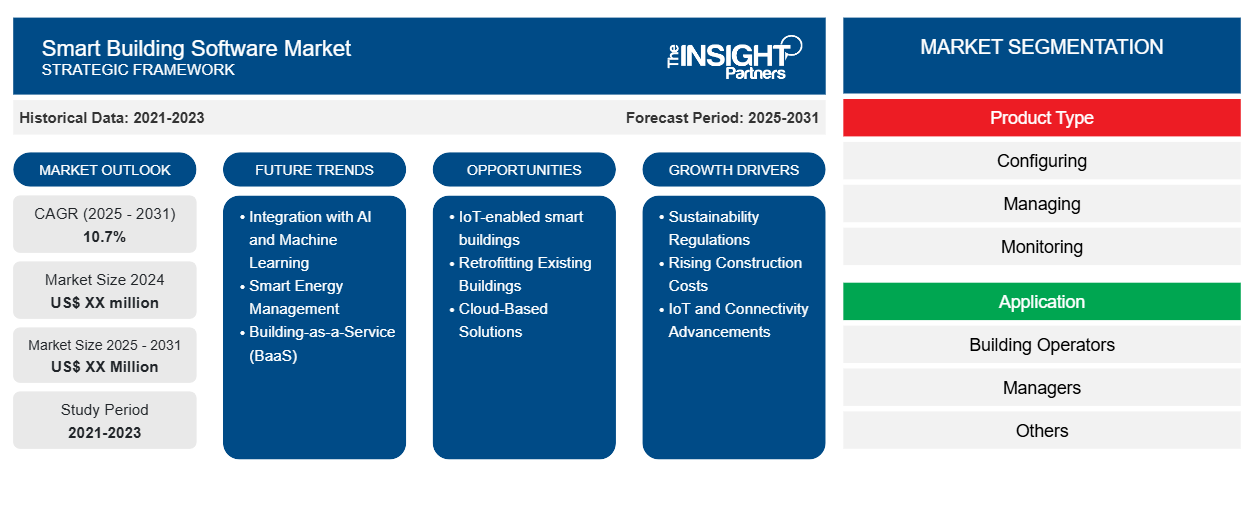من المتوقع أن يسجل سوق برمجيات المباني الذكية معدل نمو سنوي مركب بنسبة 10.7٪ من عام 2024 إلى عام 2031، مع توسع حجم السوق من XX مليون دولار أمريكي في عام 2024 إلى XX مليون دولار أمريكي بحلول عام 2031.
تم تقسيم تقرير سوق برمجيات المباني الذكية حسب نوع المنتج إلى الأقسام الفرعية التالية : التكوين والإدارة والمراقبة. كما تم تقسيمه حسب التطبيق، بما في ذلك مشغلي المباني والمديرين وغيرهم. تم تقسيم التحليل العالمي على المستوى الإقليمي وحسب البلدان الرئيسية. تم تقديم تقييم السوق بالدولار الأمريكي للتحليل القطاعي أعلاه ، مع التوقعات حتى عام 2031.
غرض التقرير
يهدف تقرير سوق برمجيات المباني الذكية الصادر عن The Insight Partners إلى وصف المشهد الحالي والنمو المستقبلي وأهم العوامل الدافعة والتحديات والفرص. وسيوفر هذا رؤى لمختلف أصحاب المصلحة في الأعمال التجارية، مثل:
- مزودي/مصنعي التكنولوجيا: لفهم ديناميكيات السوق المتطورة ومعرفة فرص النمو المحتملة، وتمكينهم من اتخاذ قرارات استراتيجية مستنيرة.
- المستثمرون: إجراء تحليل شامل للاتجاهات فيما يتعلق بمعدل نمو السوق، وتوقعات السوق المالية، والفرص المتاحة عبر سلسلة القيمة.
- الهيئات التنظيمية: لتنظيم السياسات ومراقبة الأنشطة في السوق بهدف تقليل الانتهاكات والحفاظ على ثقة المستثمرين ودعم سلامة السوق واستقرارها.
تجزئة سوق برمجيات المباني الذكية
نوع المنتج
- تكوين
- إدارة
- يراقب
طلب
- مشغلي المباني
- المديرين
- آحرون
قم بتخصيص هذا التقرير ليناسب متطلباتك
ستحصل على تخصيص لأي تقرير - مجانًا - بما في ذلك أجزاء من هذا التقرير، أو تحليل على مستوى الدولة، وحزمة بيانات Excel، بالإضافة إلى الاستفادة من العروض والخصومات الرائعة للشركات الناشئة والجامعات
- احصل على أهم اتجاهات السوق الرئيسية لهذا التقرير.ستتضمن هذه العينة المجانية تحليلاً للبيانات، بدءًا من اتجاهات السوق وحتى التقديرات والتوقعات.
عوامل نمو سوق برمجيات المباني الذكية
- لوائح الاستدامة: هناك عدد لا يحصى من اللوائح، مثل الاستدامة في إدارة المباني، والحد من البصمة الكربونية، واليقظة المتزايدة بشأن كفاءة الطاقة. وكلها تصف التبني من خلال برامج المباني الذكية.
- ارتفاع تكاليف البناء: سوف يؤدي التقدم التكنولوجي في مجال بناء المباني إلى تقليل التكاليف على المالكين حيث سيتمكنون من تحقيق الأتمتة وتحسين الطاقة والصيانة التنبؤية.
- التطورات في إنترنت الأشياء والاتصال: ستؤدي التطورات في استخدام إنترنت الأشياء ، فضلاً عن الاتصال، إلى زيادة الاستخدام الإجمالي لأجهزة إنترنت الأشياء والمساهمة في تحسين مراقبة وإدارة أنظمة المباني، مثل أنظمة التدفئة والتهوية وتكييف الهواء والإضاءة والأمن واستهلاك الطاقة.
الاتجاهات المستقبلية لسوق برمجيات المباني الذكية
- التكامل مع الذكاء الاصطناعي والتعلم الآلي: يتكامل مع الذكاء الاصطناعي والتعلم الآلي، مما يسمح للمباني الذكية بتحسين عملياتها تلقائيًا استنادًا إلى البيانات التي تم الحصول عليها في الوقت الفعلي لإجراء تعديلات على الإضاءة ودرجة الحرارة واستخدام الطاقة.
- إدارة الطاقة الذكية: يؤدي الطلب المتزايد على الطاقة بسبب الكفاءة إلى زيادة تطوير البرامج التي ستدير الطاقات بكفاءة من خلال دمج المصادر المتجددة والحد من النفايات.
- البناء كخدمة (BaaS): هنا، تصبح وظائف البناء خدمات. نماذج البناء كخدمة، حيث تتوفر وظائف البناء كخدمات، تتزايد لتسهيل المزيد من المرونة والإدارة.
فرص سوق برمجيات المباني الذكية
- المباني الذكية المدعومة بتقنية إنترنت الأشياء: تكمن هنا الفرصة لدمج برامج المباني الذكية مع هذه الجولة الجديدة من حلول إنترنت الأشياء من أجل تحقيق المزيد من الأمن وكفاءة الطاقة وراحة السكان.
- إعادة تأهيل المباني القائمة: في معظم الحالات، يمكن أن يؤدي إعادة تأهيل المباني القائمة باستخدام التقنيات الذكية لتشغيلها بشكل محسن للطاقة إلى تحسين كفاءتها التشغيلية بشكل أكبر وبالتالي يشير إلى سوق لم يتم استغلاله بعد.
- الحلول المستندة إلى السحابة: بمساعدة حلول البناء الذكية المستندة إلى السحابة، أصبح كل شيء ممكنًا: قابلية التوسع، والمراقبة عن بعد، وحتى الإدارة المركزية.
رؤى إقليمية حول سوق برمجيات المباني الذكية
لقد قام المحللون في Insight Partners بشرح الاتجاهات والعوامل الإقليمية المؤثرة على سوق برمجيات المباني الذكية طوال فترة التوقعات بشكل شامل. يناقش هذا القسم أيضًا قطاعات سوق برمجيات المباني الذكية والجغرافيا في جميع أنحاء أمريكا الشمالية وأوروبا ومنطقة آسيا والمحيط الهادئ والشرق الأوسط وأفريقيا وأمريكا الجنوبية والوسطى.

- احصل على البيانات الإقليمية المحددة لسوق برمجيات المباني الذكية
نطاق تقرير سوق برمجيات المباني الذكية
| سمة التقرير | تفاصيل |
|---|---|
| حجم السوق في عام 2024 | XX مليون دولار أمريكي |
| حجم السوق بحلول عام 2031 | XX مليون دولار أمريكي |
| معدل النمو السنوي المركب العالمي (2025 - 2031) | 10.7% |
| البيانات التاريخية | 2021-2023 |
| فترة التنبؤ | 2025-2031 |
| القطاعات المغطاة | حسب نوع المنتج
|
| المناطق والدول المغطاة | أمريكا الشمالية
|
| قادة السوق وملفات تعريف الشركات الرئيسية |
|
كثافة اللاعبين في سوق برمجيات المباني الذكية: فهم تأثيرها على ديناميكيات الأعمال
يشهد سوق برمجيات المباني الذكية نموًا سريعًا، مدفوعًا بالطلب المتزايد من المستخدم النهائي بسبب عوامل مثل تفضيلات المستهلكين المتطورة والتقدم التكنولوجي والوعي المتزايد بفوائد المنتج. ومع ارتفاع الطلب، تعمل الشركات على توسيع عروضها والابتكار لتلبية احتياجات المستهلكين والاستفادة من الاتجاهات الناشئة، مما يؤدي إلى زيادة نمو السوق.
تشير كثافة اللاعبين في السوق إلى توزيع الشركات أو المؤسسات العاملة في سوق أو صناعة معينة. وهي تشير إلى عدد المنافسين (اللاعبين في السوق) الموجودين في مساحة سوق معينة نسبة إلى حجمها أو قيمتها السوقية الإجمالية.
الشركات الرئيسية العاملة في سوق برمجيات المباني الذكية هي:
- شركة أكويتي براندز
- شركة بادي للتكنولوجيا المحدودة
- أتمتة المباني ComfortClick
- كومبتا للشركات الناشئة
- إيكوبي
إخلاء المسؤولية : الشركات المذكورة أعلاه ليست مرتبة بأي ترتيب معين.

- احصل على نظرة عامة على أهم اللاعبين الرئيسيين في سوق برمجيات المباني الذكية
نقاط البيع الرئيسية
- التغطية الشاملة: يغطي التقرير بشكل شامل تحليل المنتجات والخدمات والأنواع والمستخدمين النهائيين لسوق برمجيات المباني الذكية، مما يوفر صورة شاملة.
- تحليل الخبراء: تم تجميع التقرير على أساس الفهم العميق لخبراء الصناعة والمحللين.
- معلومات محدثة: يضمن التقرير أهمية الأعمال التجارية بسبب تغطيته للمعلومات الحديثة واتجاهات البيانات.
- خيارات التخصيص: يمكن تخصيص هذا التقرير لتلبية متطلبات العملاء المحددة وبما يتناسب مع استراتيجيات العمل بشكل مناسب.
وبالتالي، يمكن أن يساعد تقرير البحث حول سوق برمجيات المباني الذكية في تمهيد الطريق لفك شفرة وفهم سيناريو الصناعة وآفاق النمو. ورغم وجود بعض المخاوف المشروعة، فإن الفوائد الإجمالية لهذا التقرير تميل إلى التفوق على العيوب.
- التحليل التاريخي (سنتان)، سنة الأساس، التوقعات (7 سنوات) مع معدل النمو السنوي المركب
- تحليل PEST و SWOT
- حجم السوق والقيمة / الحجم - عالمي، إقليمي، بلد
- الصناعة والمنافسة
- مجموعة بيانات إكسل
التقارير الحديثة
تقارير ذات صلة
شهادات العملاء
سبب الشراء
- اتخاذ قرارات مدروسة
- فهم ديناميكيات السوق
- تحليل المنافسة
- رؤى العملاء
- توقعات السوق
- تخفيف المخاطر
- التخطيط الاستراتيجي
- مبررات الاستثمار
- تحديد الأسواق الناشئة
- تحسين استراتيجيات التسويق
- تعزيز الكفاءة التشغيلية
- مواكبة التوجهات التنظيمية





















 احصل على عينة مجانية ل - سوق برمجيات المباني الذكية
احصل على عينة مجانية ل - سوق برمجيات المباني الذكية